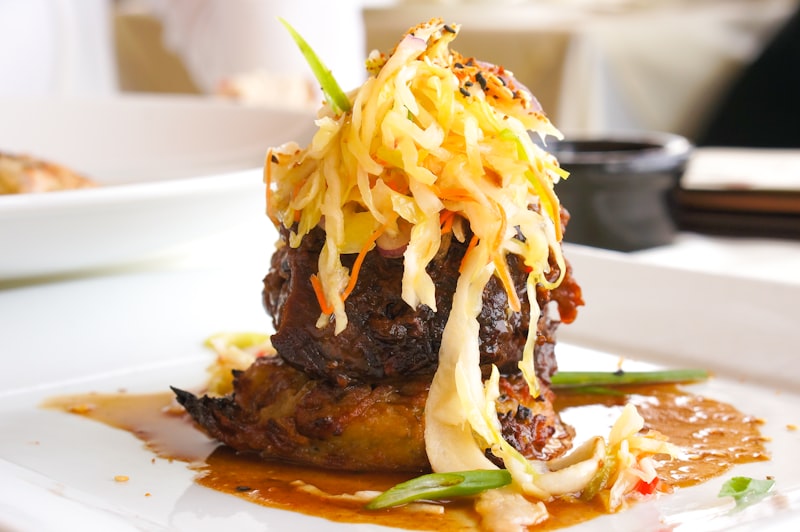When it comes to the world of culinary arts, certain countries stand out as pioneers and trendsetters. These nations not only excel in creating delicious dishes but also leave a lasting impression on global gastronomy. Let’s delve into the leading countries that have shaped the culinary landscape.
Italy, renowned for its rich culinary heritage, is synonymous with pasta, pizza, and gelato. Italian cuisine emphasizes fresh, simple ingredients cooked to perfection. From the creamy risottos of Milan to the hearty ragùs of Bologna, each region boasts unique flavors that celebrate local produce.
France, often hailed as the epitome of fine dining, takes culinary artistry to new heights with its meticulous techniques and elegant presentations. French cuisine is a symphony of flavors and textures, from buttery croissants and escargot to exquisite desserts like crème brûlée and macarons. Paris, the capital, remains a global hub for gastronomic innovation.
Japan, known for its precision and reverence for ingredients, offers a culinary experience rooted in tradition and meticulous craftsmanship. Sushi, sashimi, and tempura showcase the artistry of Japanese chefs, who elevate raw fish and seafood into culinary masterpieces. Each dish reflects a deep respect for seasonality and aesthetics.

Mexico, with its vibrant and diverse flavors, brings a fiesta of taste to the table. From tangy ceviche to savory tacos and rich mole sauces, Mexican cuisine is a tapestry of indigenous ingredients like corn, chili peppers, and cocoa. Street food culture thrives in cities like Mexico City, where vendors serve up tantalizing treats like tamales and elote.
India, famed for its spicy curries, aromatic biryanis, and tandoori specialties, offers a culinary journey that spans a multitude of flavors and traditions. Each region in India boasts its own culinary identity, from the vegetarian delights of Gujarat to the seafood-rich dishes of Kerala. Indian cuisine dazzles with its use of spices and bold flavors.

Spain, celebrated for its tapas culture, showcases a diverse culinary landscape influenced by its Mediterranean climate and regional diversity. From the paellas of Valencia to the pintxos of Basque Country, Spanish cuisine emphasizes communal dining and the art of sharing small plates bursting with flavor.
These countries not only define culinary excellence but also inspire chefs and food enthusiasts worldwide. Whether you’re savoring pasta in Italy, sushi in Japan, or tapas in Spain, each bite tells a story of cultural heritage and culinary innovation, making these nations true leaders in the art of food.
This article highlights the uniqueness and cultural richness of each country’s culinary traditions, aiming to engage readers with vivid descriptions and a conversational tone.
Gastronomic Capitals: Exploring the Culinary Prowess of France and Italy
French cuisine is synonymous with elegance and sophistication. It’s like a well-orchestrated symphony where each ingredient plays a crucial role. From the buttery goodness of croissants to the complex flavors of coq au vin, French food is a celebration of culinary artistry.
One cannot discuss French cuisine without mentioning the iconic dishes from different regions. Whether it’s the bouillabaisse from Provence or the cassoulet from Languedoc, each dish tells a story of tradition and terroir. French chefs pride themselves on using fresh, local ingredients to create dishes that are both comforting and innovative.
The French approach to cooking is all about technique. From mastering the perfect béarnaise sauce to expertly searing a foie gras, French chefs undergo rigorous training to perfect their craft. It’s a blend of skill, intuition, and respect for ingredients that sets French cuisine apart.
Italian cuisine, on the other hand, is a celebration of simplicity and bold flavors. It’s like a warm embrace from a nonna (grandmother) who knows the secret to a perfect ragù. From the first bite of a crispy, wood-fired pizza to the last spoonful of creamy tiramisu, Italian food evokes a sense of comfort and joy.
Regional diversity is at the heart of Italian cuisine. Each region boasts its own specialties, influenced by local produce and culinary traditions. Whether you’re indulging in risotto alla milanese in Milan or savoring the earthy truffle dishes of Umbria, every meal tells a story of Italy’s rich cultural tapestry.

Italian cooking revolves around the freshness and quality of ingredients. Simple yet flavorful dishes like pasta pomodoro or bruschetta highlight the importance of using the best tomatoes, olive oil, and herbs. It’s about letting the ingredients shine without unnecessary fuss.
Asian Delights: How Japan and Thailand Are Redefining Culinary Excellence
Japan, renowned for its meticulous attention to detail, elevates food preparation to an art form. Sushi, perhaps its most famous export, epitomizes the harmony of simplicity and precision. Each slice of fresh fish atop seasoned rice is a testament to centuries of refinement, where the balance of flavors and textures is paramount. Beyond sushi, Japan’s culinary landscape spans a spectrum from comforting bowls of ramen to the theatrical flair of teppanyaki, where chefs skillfully grill meats and seafood before a captivated audience.
In contrast, Thailand’s cuisine dazzles with its bold flavors and aromatic spices. Thai food is a symphony of sweet, sour, salty, and spicy, harmoniously blended in dishes like Pad Thai, Tom Yum soup, and Green Curry. Thai chefs masterfully balance these elements, creating dishes that are not just meals but experiences. Every bite tells a story of Southeast Asian culture, where street vendors and royal kitchens alike contribute to a culinary heritage that embraces diversity and innovation.
Both Japan and Thailand share a reverence for fresh ingredients, seasonal produce, and the art of presentation. In Japanese cuisine, the concept of “shun” guides chefs to use ingredients at the peak of their flavor, ensuring every dish bursts with vitality. Similarly, Thai cooking celebrates the bounty of herbs, vegetables, and spices that adorn its dishes, offering a sensory journey through its bustling markets and rural landscapes.
As global ambassadors of flavor, Japan and Thailand continue to redefine culinary excellence, inspiring chefs and food enthusiasts alike to embrace tradition while pushing the boundaries of taste. Whether enjoying the refined simplicity of Japanese cuisine or the explosive flavors of Thai street food, one thing is certain: each dish invites us to savor the essence of Asia’s culinary mastery.
From Tacos to Tequila: Mexico’s Rise as a Global Food Powerhouse
When you think of Mexico, what comes to mind? Perhaps vibrant culture, stunning landscapes, or maybe even delicious food. But did you know that Mexico is not just known for its tacos and tequila anymore? Over the past few decades, this beautiful country has emerged as a global food powerhouse, captivating taste buds around the world with its diverse and flavorful cuisine.
One of Mexico’s most iconic culinary exports is, of course, the taco. These handheld delights have transcended borders, becoming a beloved street food from New York City to Tokyo. What makes Mexican tacos so special? It’s not just about the tortilla and the filling; it’s about the blend of spices, the freshness of ingredients, and the cultural heritage that each bite embodies. From the simple yet savory carne asada tacos to the more adventurous lengua (beef tongue) tacos, there’s a flavor profile to suit every palate.
Beyond tacos, Mexico boasts a rich tapestry of regional dishes that highlight its culinary diversity. Take, for instance, mole poblano, a complex sauce made with chocolate and chilies that pairs perfectly with chicken. Originating from the state of Puebla, mole poblano is a testament to Mexico’s mastery of blending sweet, savory, and spicy flavors into a harmonious dish that delights the senses.
And let’s not forget about Mexico’s national spirit: tequila. Made from the blue agave plant, which thrives in the volcanic soil of Jalisco and a few other designated regions, tequila has evolved from a local drink to a global phenomenon. Whether sipped neat, enjoyed in a cocktail like the classic margarita, or used as a flavorful marinade for meats, tequila has become synonymous with celebration and good times.
Mexico’s rise as a global food powerhouse isn’t just about traditional dishes and drinks; it’s also about innovation and sustainability. Chefs across Mexico are blending ancient techniques with modern trends, creating dishes that are both timeless and contemporary. Farm-to-table dining experiences are gaining popularity, showcasing the country’s abundant agricultural resources and commitment to quality.
Spice Routes and Beyond: India and Thailand’s Influence on Global Cuisine
In India, spices are not mere ingredients; they are storytellers of centuries past. From the fiery warmth of red chili to the earthy richness of cumin and coriander, each spice adds its own melody to India’s culinary orchestra. Indian cuisine dances between regions, from the robust curries of the north to the coconut-infused dishes of the south, each bite a revelation of culture and history.
Thailand, too, offers a culinary adventure like no other. Thai cuisine is a celebration of balance – sweet, sour, salty, and spicy harmonize in dishes like Pad Thai and Tom Yum soup. Thai chefs masterfully blend fresh herbs like lemongrass and Thai basil with spices such as galangal and chili, creating dishes that are both vibrant and complex.
Together, India and Thailand have influenced global cuisine in profound ways. Their spice routes, once ancient trade paths, are now bustling highways of flavor that connect continents. Dishes like Indian butter chicken and Thai green curry have become beloved staples in restaurants worldwide, their origins tracing back to the kitchens of Mumbai and Bangkok.
But their influence goes beyond just spices. Indian and Thai cooking techniques, from tandoor grilling to stir-frying, have been adopted and adapted in kitchens from New York to Tokyo. Even desserts have not been spared; who can resist the allure of mango sticky rice or Indian kulfi ice cream?
As global palates evolve, so too does the influence of Indian and Thai cuisines. Their flavors continue to inspire chefs and home cooks alike, pushing the boundaries of what is possible in the culinary world. So the next time you savor a dish infused with curry or garnished with cilantro, remember the journey it took to reach your plate – a journey that began centuries ago on the spice routes of India and Thailand.
A Taste of Tradition: Spain and Greece in the Culinary Limelight
Step into the vibrant culinary worlds of Spain and Greece, where tradition dances on the taste buds and history flavors every dish. These Mediterranean giants have long captivated food enthusiasts worldwide with their rich flavors and cultural depth.
In Spain, every bite tells a story of its diverse regions. From the sizzling paellas of Valencia to the robust flavors of Andalusian gazpacho, Spanish cuisine reflects a tapestry of influences—from Moorish to Mediterranean. Tapas, those delightful small plates meant for sharing, embody the social spirit of Spain, inviting diners to sample a myriad of flavors in a single meal.
Meanwhile, Greece offers a taste of the ancient intertwined with the modern. Its cuisine, built on simplicity and freshness, celebrates the bounty of the land and sea. Picture savory moussaka layered with eggplant and minced meat, drizzled with creamy béchamel sauce—a dish that speaks of comfort and tradition. And who can resist the tangy allure of tzatziki, a yogurt-based dip perfumed with garlic and cucumber, perfect alongside grilled meats or as a dip for warm pita bread?
Both countries boast not just recipes, but culinary philosophies that emphasize quality ingredients and communal dining. It’s about more than just eating—it’s about coming together, sharing stories, and savoring life’s simple pleasures. Whether you find yourself in a bustling Spanish tapas bar or a cozy Greek taverna overlooking the Aegean Sea, each meal is an invitation to experience history and culture through the universal language of food.

Indulge in the essence of Spain and Greece, where every dish whispers tales of ancient civilizations and modern-day vibrancy. Let your taste buds wander through landscapes rich in flavor and tradition, and discover why these Mediterranean cuisines continue to shine brightly on the global culinary stage.
This article blends the flavors of Spain and Greece while emphasizing their cultural significance and culinary appeal, all in a conversational tone to engage the reader.
Beyond Sushi: Japan’s Fusion of Tradition and Innovation in the Kitchen
Imagine stepping into a tiny izakaya tucked away in Kyoto’s historic streets. Here, the delicate art of kaiseki cuisine unfolds, a meticulously crafted multi-course dining experience that dates back centuries. Each dish is not just a meal but a work of art, reflecting the seasons and honoring local ingredients like tender bamboo shoots or prized Wagyu beef.
Yet, Japan’s culinary journey doesn’t stop at tradition’s door. It’s a journey that embraces innovation with open arms. In bustling Tokyo, you might find yourself at a futuristic ramen joint where steaming bowls of noodles are served by robots. The umami-rich broth is still made with the same dedication to flavor, but the experience is a blend of tradition and cutting-edge technology.
Across Japan, chefs are redefining what it means to innovate while preserving culinary roots. Take, for instance, the art of tempura. Traditionally a street food staple, today’s tempura chefs elevate this dish to new heights by using unique ingredients like asparagus or even ice cream, all coated in a delicate, crispy batter that’s both timeless and inventive.
Japan’s culinary scene is a testament to the country’s ability to honor tradition while embracing the future. It’s a place where ancient tea ceremonies coexist with avant-garde dessert cafes, where the simple act of eating becomes a journey through history and innovation alike. Whether you’re savoring a bowl of tonkotsu ramen in Osaka or sampling Kyoto’s delicate wagashi sweets, Japan offers a culinary adventure that blends the old and the new in ways that continue to captivate and inspire.
As you explore Japan’s kitchens, you’ll discover that beyond sushi lies a world where tradition and innovation dance together, creating flavors and experiences that are as unforgettable as they are delicious.
Mediterranean Mastery: Italy, Greece, and the Secrets of Their Timeless Dishes
Let’s start with Italy, the birthplace of pizza, pasta, and gelato. Italian cuisine is a celebration of fresh ingredients, simplicity, and passion. Each region in Italy boasts its own specialties, from the hearty Bolognese sauce of Emilia-Romagna to the delicate seafood risottos of Venice. Italians take their food seriously, with recipes often passed down through generations like cherished family heirlooms.
On the other hand, Greece offers a taste of the Mediterranean with its sun-drenched islands and a cuisine that reflects its ancient roots. Greek dishes are known for their bold flavors, with ingredients like olive oil, feta cheese, and fragrant herbs playing starring roles. Whether it’s the iconic Greek salad with its juicy tomatoes and briny olives or the comforting moussaka layered with eggplant and minced meat, Greek food is a culinary journey through history.
What makes these cuisines truly timeless are not just the ingredients but also the stories behind each dish. Imagine biting into a slice of Margherita pizza and tasting the history of Naples, or savoring a bite of spanakopita and feeling transported to a sunny terrace overlooking the Aegean Sea. These dishes are not just meals; they are experiences that connect us to the past and each other.

So, the next time you sit down to a plate of spaghetti carbonara or a platter of grilled souvlaki, take a moment to appreciate the Mediterranean mastery that has captivated taste buds for centuries. Italy and Greece have unlocked the secrets to creating dishes that are as unforgettable as they are delicious, ensuring that their culinary legacies will continue to inspire and delight for generations to come.
Frequently Asked Questions
Which Asian countries are renowned for their culinary traditions?
Discover the culinary delights of Asia with our concise guide to the countries celebrated for their rich culinary traditions.
What are the top countries known for their culinary excellence?
Discover the top countries celebrated for their culinary expertise and diverse flavors, showcasing rich cultural heritage through their cuisine.
How does France rank among the leading countries in culinary arts?
Discover how France’s culinary tradition secures its place among global leaders. Explore its rich heritage, from haute cuisine to regional specialties, showcasing innovation and tradition. Learn why France remains a top destination for culinary enthusiasts worldwide.
Which countries outside Europe have made significant contributions to global cuisine?
Discover which countries beyond Europe have greatly influenced global cuisine. Explore the culinary contributions of nations like India, China, Thailand, Mexico, and Peru, each enriching the world’s dining experiences with diverse flavors and unique cooking techniques.
What makes Italy a prominent figure in the culinary world?
Discover why Italy stands out in the culinary world with its rich diversity of regional cuisines, time-honored traditions, fresh local ingredients, and passionate dedication to authentic flavors.


